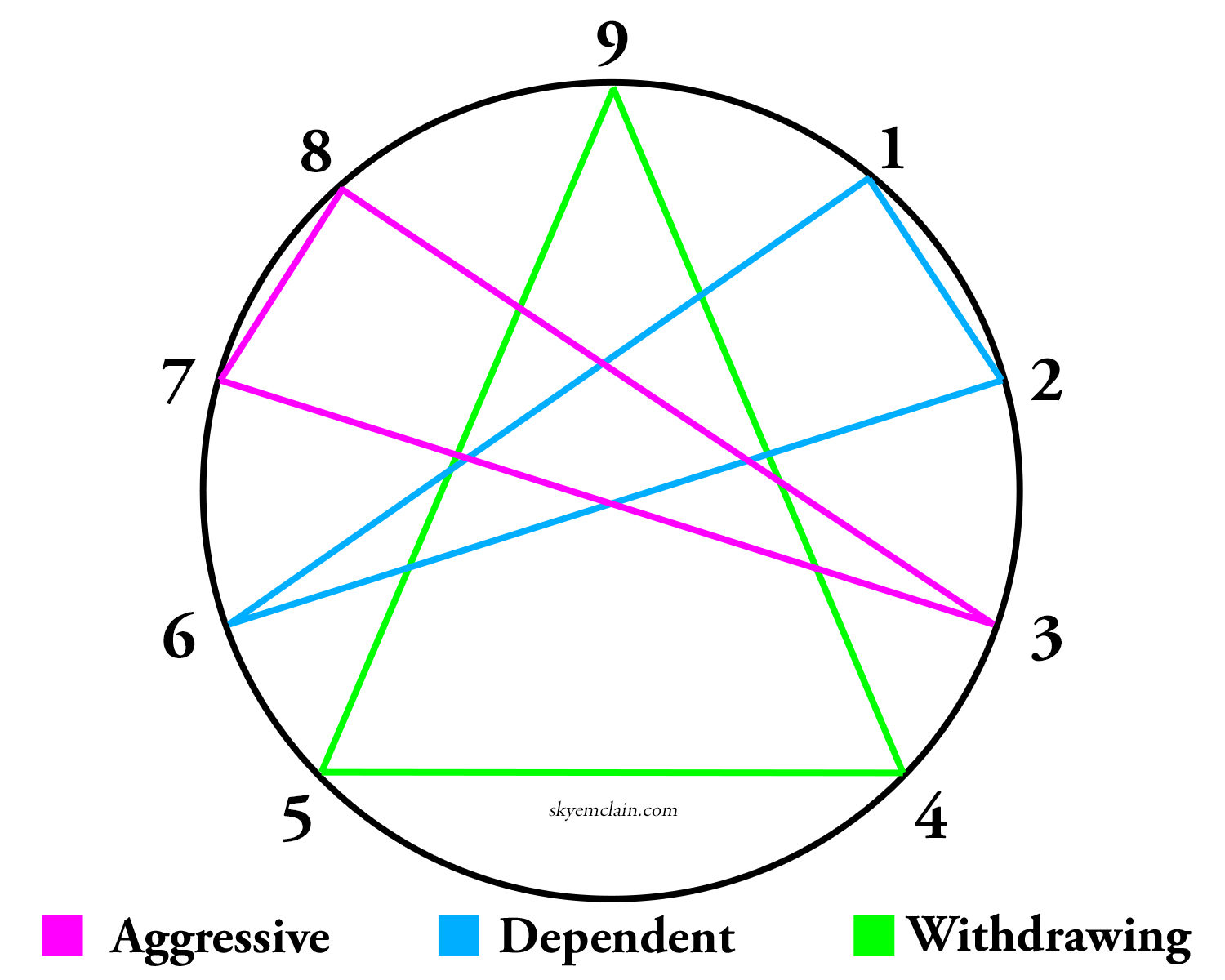I bet you’ve been wondering how to find your Enneagram number, haven’t you? Everyone is talking about it and there is a LOT of information circulating about it right now. Here is how to find your Enneagram number WITHOUT taking a test!
The Enneagram is HOT right now which is something I both love (because I love the Enneagram) and simultaneously hate (because there is a lot of misleading information out there). While I have known about the Enneagram for several years, I never really did a deep dive into it until recently. I took a class in the fall of 2018 called The Enneagram Journey, written by Suzanne Stabile, and my mind was officially blown open. While I did already know my number, discovering the true power of Enneagram wisdom and Enneagram work broke open a whole new side of me that I did not know was ever there.
Today I am here to plead with you to not take an online Enneagram assessment to ascertain your Enneagram type or number. There are hundreds of them out there and I do not fully trust a single one. I talked a bit about this on my Instastories recently (linking that highlight here if you want to go listen to me blabber on about it) but sometimes the written word is taken in better, so I wanted to put it in a blog post too.

I also want to teach you a little about the Enneagram that I learned from Suzanne’s course that I rarely, if ever, hear discussed by so-called “Enneagram gurus” that are out there. I’m not discrediting anyone here, but I am telling you to do your OWN research on the Enneagram and the different types. Do not go off of what anyone tells you that you are – only you can determine that for yourself. Don’t even fully trust me, because I’m a young student of the Enneagram and still have a lot to learn about it.
How to Find Your Enneagram Number
All that being said, if I don’t want you to find out what your number or type is via a test, then just how the heck are you supposed to? Well, I thought you’d never ask. Let’s get started!
What is the Enneagram?
To state it as simply as possible, the Enneagram is an ancient system that identifies nine different personality types. These nine different types, represented by numbers, each represent a different way that someone views the world, takes in and processes information, and responds to situations.
Each personality or number is determined by a motivation, not a behavior. Motivations include a basic passion, sometimes called a sin or a besetting sin, and a basic desire. As an example – I’m a seven on the Enneagram. My basic passion is gluttony (romantic, eh?) and my basic desire is happiness. Each number has a different besetting sin and a different desire and their view on the world is determined by those two things.
The Enneagram is visually represented by a circle with nine points around the circumference. Each number is connected to two other numbers by an arrow and these arrows represent the dynamic relationship between these numbers. Each number makes a move to one number when it must care for itself (a stress move) and to another number to experience holistic healing (a security move).

The Purpose of the Enneagram
A person’s Enneagram is like a mask – it is a tool they use to process the world around themselves that they put on at a very early age. The goal of discerning and understanding your number is to use this knowledge to remove that mask and become more of who God is calling you to be.
Another objective of the Enneagram, aside from maturing beyond the limits of your own personality, is to use Enneagram knowledge to improve relationships with others. Learning how another person works, and how their Enneagram type is masking who they truly are, gives you a level of compassion for humanity that you have never had before.
Conversely, much like it is discussed in social media today, it is NOT to be used as a crutch or as an excuse for behavior. My goal is to teach people that finding out your Enneagram number is the very beginning of the journey, not the final destination.
Suzanne teaches in the Enneagram Journey in such a way that you start with a broad overview of the Enneagram and then through the next three sessions you begin to narrow down on a number by first teaching about Stances, then Triads, and then doing a tour through each number.
Each number on the Enneagram is a unique combination of a stance and a triad. For example, a seven such as myself resides in the Head (or Fear) Triad and has an Aggressive Stance. No other number in the Enneagram has that combination and that is what makes each number unique.
Stances
There are three stances in the Enneagram, the Aggressive stance, the Dependent stance, and the Withdrawing stance. A person’s stance is how they move through the world. I’ve outlined a couple of the characteristics of each stance below.

Aggressive Stance
An individual in the aggressive stance might display some or all of the following traits:
- When they walk in to a room they garner attention quickly without looking like their putting forth the effort to do so
- They seem to have a lot of never-ending energy.
- They are skilled at orienting others to their own ideas, which comes off as pushy, and are excellent at reframing and reshaping situations into a positive light.
- They prefer to say too little over too much and protect themselves with humor.
- They are upbeat and optimistic and make people feel safe but don’t intuitively connect with the feelings of others.
- They are all about control and feel that other people move too slowly for them.
Dependent Stance
An individual in the dependent stance might display some or all of the following traits:
- They are always thinking “What should be done next?”
- They place their life’s reference point outside of themselves and are all about other people.
- They are concerned about your feelings and want to respond to other people in a way that is good for everyone.
- They are good at connecting everyone and everything and sometimes chain things together that are not related at all.
- They have trouble with their own boundaries and people with established boundaries often hurt their feelings.
Withdrawing Stance
An individual in the withdrawing stance might display some or all of the following traits:
- They are independent and non-aggressive and count on their own strength and knowledge to deal with stressful situations.
- They are aware that there is a lot around them that needs to be done, but that their presence doesn’t make a difference.
- Their inner world is their real world because they don’t connect to people easily.
- They handle difficult situations with resentful accommodations.
- They have lots of daydreams and inner thoughts and deal with stress by pulling back and not dealing with it.
If one of these sounds like you, write it down and set it aside for now. We will come back to it in a bit.
Triads
Just like there are three stances, there are also three triads in the Enneagram: the Head triad, the Heart triad, and the Gut triad. These triads are determined by which center (your head, heart, or gut) you filter life through FIRST.

An individual in the Head triad filters information through their thoughts first, before deciding how to react or feel about it. Someone in the Heart triad feels information first, then reacts, and then thinks about last. Finally, a person in the gut triad has a gut reaction first, then immediately wants to do something about it, and then thinks about it last.
Head Triad
A person in the head triad might:
- Make mental connections that are not easily seen by others.
- Live by a specific plan
- Have no idea how much they are truly valued
- Keep thinking on something after others have moved on
- Be suspicious of other’s motives
- Observe rather than relate
- Privately worry that they are wrong
Heart triad
A person in the heart triad might:
- Believe that connection with others is more important than anything else
- Worry how they are perceived
- Play out their emotions by externalizing them, internalizing them, or forget them altogether.
- Be familiar with anxiety and how it affects them
- Have a hard time asking for help
- Need to be relationally connected
Gut Triad
A person in the gut triad might:
- Feel the world with their belly and have true gut insticts
- Try to control both their inner world and their outer world
- Convert lots of emotions into anger
- Follows an instinctual hunch
- Do their part and everyone else’s part
- Want to impact the world and dismiss you/others in the process
Finding Your Number
As I mentioned earlier, each Enneagram type is a unique combination of one stance and one triad. Reference what you wrote down as your stance and combine it with your triad to find your number. So the numbers go as follows:
- Nine: Withdrawing Stance // Gut Triad
- One: Dependent Stance // Gut Triad
- Two: Dependent Stance // Heart Triad
- Three: Aggressive Stance // Heart Triad
- Four: Withdrawing Stance // Heart triad
- Five: Withdrawing Stance // Head Triad
- Six: Dependent Stance // Head Triad
- Seven: Aggressive Stance // Head Triad
- Eight: Aggressive Stance // Gut Triad
If this all seems overwhelming to you, don’t worry. I’m still swimming it it all myself. But the way Suzanne teaches it requires you to do some serious self discovery and self observation. First you determine your stance, then you determine your triad, and where those two intersect you’ll find your Enneagram number.
Learning More
If you want to read more about your number OR if you still aren’t sure what your number is because you can’t decide what stance or triad you might be in (it is not uncommon to feel torn between two), then start by exploring all of the numbers by reading the Road Back to You, written by Suzanne Stabile and Ian Cron.
The Road Back to You is a complete description of each number in detail, including its besetting sin (or passion), it’s main desires, it’s stress and security moves, and its wings.
Here is how you will know when you’ve reached your number. You might feel a bit embarrassed by it. You will likely feel “found out”, like someone has just revealed some of your deepest, darkest secrets to the world. It will make you a bit uncomfortable. Richard Rohr, says “If you don’t sense the whole thing as somehow humiliating, you haven’t yet found your number.”
As you reach the bottom of this post I want to remind you that I myself am still learning and this is just scraping the surface of the Enneagram. My goal is that you do some soul searching and start to understand yourself as who you are to the world, and who God is calling you to be, in order to determine your Enneagram type.
If you have any questions leave them in the comments below and I’d be happy to start a discussion with you!

What a wonderful and thorough job you did explaining this. Like you I do love the Enneagram – learning about it has given me freedom – and ways to improve myself and my life!
Thank you for your clarity!